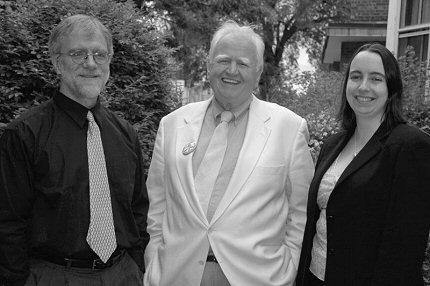The struggle for ballot access
Share
New York runs a strong campaign but doesn’t make it
By Peter Lavenia
Co-Chair, Green Party of New York State
Winter 2007
The elections of 2006 were a mixed bag for Greens in New York State. On one hand, the Party enjoyed its best result ever in a (non-presidential) statewide race, as comptroller candidate Julia Willebrand polled 117,908 votes (2.85 percent). Sadly, gubernatorial candidate Malachy McCourt received only 42,166 votes – short of the 50,000-vote threshold needed to regain ballot status for the Green Party of New York State (GPoNYS).
For U.S. Senate, Howie Hawkins provided the anti-war alternative to Senator Hilary Clinton, polling 55,469 votes (1.24 percent) in the face of her steamroller campaign. This is more than any other Green senate candidate has received in New York previously. Attorney general candidate Rachel Treichler pulled in 61,849 votes (1.44 percent).
“Although regaining ballot access was the party’s primary goal,” said state co-chair Gloria Mattera “and unfortunately not reached, our candidates managed to do an admirable job of promoting the party and its causes throughout the campaign.”
McCourt and Alison Duncan (lieutenant governor nominee) ran on a platform which exposed the deep divides between rural and urban New York, along with the gaping class chasm in this state. Their campaign also made a centerpiece of universal health care and bringing the National Guard home from Iraq.
The other statewide candidates also held the Green flag high for all to see. Going against the nation’s top fundraiser, Clinton, Hawkins stayed grassroots, putting together multiple statewide and campus tours which in turn helped resurrect the Campus Greens in New York. A few weeks before the election, Hawkins even reached double-digits in a Zogby poll. The issues prominent in his campaign were: universal health care, an end to the war, and jobs for all.
In the Attorney General’s race, Treichler got the League of Women Voters to pull its sponsorship of a candidate debate. This was because she was denied access to the two-party debate despite receiving 17 percent support among independent voters in Zogby polls.
“This was a coup of the highest order; forcing the League to respect basic principles of democracy and explaining that Green candidates deserved to be heard alongside Republican and Democratic candidates,” said Treichler.
She also raised an issue seemingly taboo to other attorney general (AG) candidates – the AG’s responsibility to revoke corporate charters of corporations that violate the public trust.
Finally, Willebrand became a minor celebrity in the wake of a scandal involving incumbent New York comptroller, Alan Hevesi, who misused state funds and later stepped down after admitting his guilt (See page 2). Many press agencies, including the New York Times, discussed her as a possible alternative, given the outright fraud of the Democratic incumbent and the questionable competence of the Republican challenger.
Just as with Treichler’s campaign, Willebrand spotlighted the potential to work for justice in her office, in a way no other candidate would even discuss – the role the comptroller could play in directing the socially conscious investing of state pension funds, and what that would mean for New York.
“If elected,” the Times wrote about Willebrand, “she says she would use the post to end handouts to corporations, crack down on Medicaid fraud and create government incentives to promote environmental projects, affordable housing and new jobs.”
The first statewide television ads for a Green gubernatorial and U.S. senate candidate in New York were run in 2006 with great success. The amount of donors to the campaigns and interest in the websites spiked immediately after the airing of the ads. So with all this good press, why didn’t the Green Party regain ballot status?
Unfortunately for New York Greens, only the governor’s race can gain (or regain) ballot status – ironically the only statewide race in this election, which the GPoNYS did not pass the 50,000-vote threshold.
Why? Many New York voters had no idea that only a vote for governor would give the Greens a ballot line. For others, even though they were supportive of Green ideas, the celebrity of well-known Democrat Eliot Spitzer, the eventual gubernatorial victor, swayed them. In still other instances, the limited statewide network of Greens to follow up on candidate visits meant some potential votes were never nailed down.
As to the ability of the Greens to pick up the anti-war vote, Hawkins said, “to the degree that voters were making choices based upon the parties themselves, the false idea that the Democrats were running on an anti-war platform probably hurt us most of all.”
Beyond this, Greens were hurt by the existence of ballot-line fusion in New York. Voters ended up mislead by pseudo-third parties like the Working Families, Conservative, and Independence parties who gave their ballot lines to Democrats and Republicans instead of running independent candidates. Working Families was able to keep its ballot line because it endorsed Democrat Eliot Spitzer for governor and received 155,000 votes (and a quarter of a million dollars from the Spitzer campaign for their ballot-line “donation”). The Greens, running an independent candidate on a shoestring budget, could not hope to compete.
Examining other states without fusion shows how well Greens can do: in Illinois, where the Greens received over 10 percent of the gubernatorial vote, Greens were third on the ballot line. Because of the fusion parties in New York, the Greens were eighth and barely got 1 percent for most candidates.
This is the second time in a row the GPoNYS has failed to regain the ballot status it first achieved in 1998, when Al Lewis received 52,533 for governor. In 2002, Stanley Aronowitz received 41,797 votes and now with McCourt’s total, the party has fallen short again.
After the 2002 elections, the Greens were threatened with losing their party membership. New York state law dictates when a party loses its statewide ballot status, its enrolled members become un-enrolled turning into independent voters. The Party also cannot enroll any new members until it achieves ballot status again.
The GPoNYS, together with the Brennan Center for Justice, challenged this law and won an injunction to prevent the state from automatically converting all enrolled Greens to independents.
New York is one of only three states that doesn’t even provide a blank line in the “political party” choice area of the voter registration form. The Green Party successfully argued that by prohibiting people from enrolling in the party of their choice, the State of New York violates the First Amendment’s free-association rights and the 14th Amendment’s equal-protection clause. Given they were able to successfully petition to get statewide candidates on the ballot again in 2006, voters will still be given a choice to register with the Green Party, and the State Board of Elections will keep enrollee lists.
Looking ahead, New York Greens plan to focus on local elections in 2007 and build upon the eight municipal level officeholders they have already led by Mayors Jason West (New Paltz) and Mike Sellers (Cobbleskill).
“If what does not kill us, makes us stronger,” said Sally Kim, manager of the Hawkins for Senate campaign, “then this campaign may have wounded us, but the New York State Greens will be back very soon, more vigorous than ever.”
For more information: www.gpnys.org/





